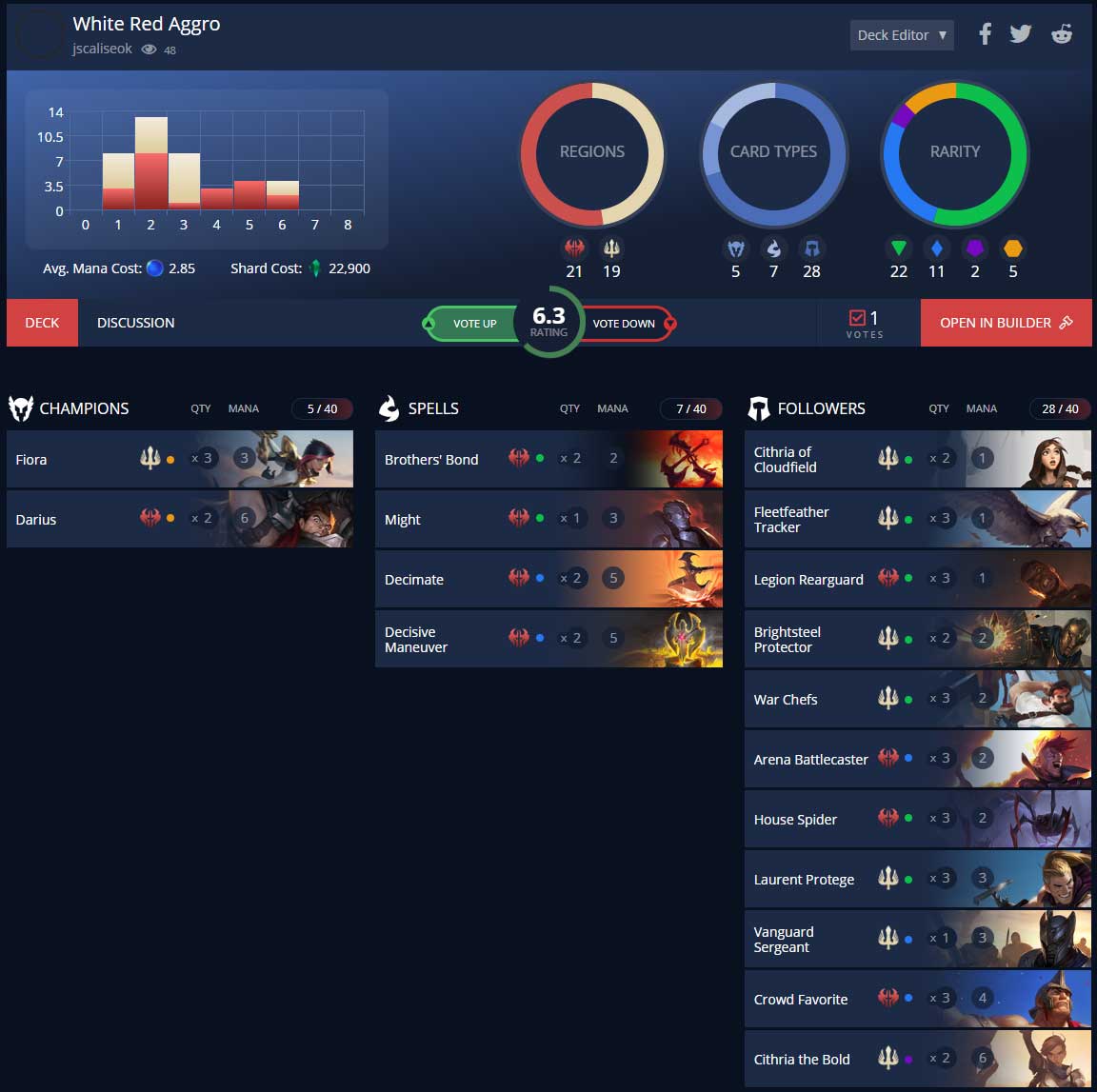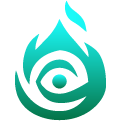New nerfs. New decks. Legends of Runeterra has just seen it's second balance patch, and it shakes up the meta in a big way. While the top lists and archetypes are still in positions of power, they don't have quite the same hold they've had over the past few weeks.
To take advantage of the new meta, we're going back to aggro. This week's deck blends Demacia with Noxus to create a low-curve, high-damage build that starts beating on turn one and never looks back. While fighting through slow control is never easy, this has enough powerful tools to lock out games in a hurry. If you want to go fast, this is for you.
The Champions
This deck, being an aggro build, needs powerful heroes that can end the game in a hurry. Both
Fiora and
Darius fit that plan perfectly, but they do so in strictly different ways. Where Fiora is a great early game tool, Darius simply exists to get in finishing points of damage at the top-end of the curve.
Unlike other
Fiora builds, the three drop isn't here to win the game. Though you can get some victories through her leveled-up form, she mainly exists to scare your opponent. Many people will commit a lot of resources to taking her down. Know that, and do your best to keep your opponent's focus on her. The more cards they spend taking her down, the less removal your other units need to worry about.
Also note that challenger is an incredibly powerful ability. Not only does it help you pace combat, but it clears the way for your smaller followers to get through. Fiora should always try to trade down when possible, but there will be times where she just dies to take out an annoying wall.
Darius, unlike Fiora, is much more explanatory. The giant six drop brings the pain in a hurry. The only note here is to always position him at the right of the attacking line when he's not leveled up. That forces your opponent to block your other units so he doesn't become big and kill them through overwhelm damage.
Kicking Things Off
As with any aggro deck, the goal here is to get on the board early and start pouring on damage as quickly as possible. There are several ways to make that happen, but they all focus on getting in from turn one onwards.
Cithria of Cloudfield,
Legion Rearguard, and
Fleetfeather Tracker are your three one drops here. You want to aggressively mulligan for one of these each game, with the goal being to always get onto the board turn one.
Rearguard is perhaps the best of the three units when it comes to early pressure. Not only can it slam for three damage, but it also gets worse as the game goes long. Not being able to block can be a real liability during the middle phase, but it rarely matters on turns one or two.
Fleetfeather Tracker also brings the damage, but is a bit more nuanced than the other two one drops. The ability to gain challenger does wonders in terms of clearing blockers or shutting down problematic early threats you otherwise can't handle. Even taking down a single elusive unit can be the difference between winning and losing. The bird also gives you the rare ability to adapt to your opponent's board, which is something so few aggro decks can do.
Backing up those three cards are
Arena Battlecaster and
House Spider. This pair is pretty self-explanatory from an aggressive standpoint because both pour on damage in their own way.
The spider creates two bodies, which then plays into cards like Battlecaster,
Crowd Favorite and
Brothers' Bond. An extra 1/1 may not seem like much, but it goes a long way in a deck that wants to get in as much chip damage as possible. It also creates two blockers, which can come in handy during a race.
On the other hand, Battlecaster instantly turns a small board into an army of threats. Just be aware that you don't always need to go big with the 2/2. Even getting one on-curve attack can be enough pressure as you move into the middle game.
Ample Protection
The above cards kick off your curve and quickly pour on damage. However, followers are only as good as long as they're on the board. It's quite easy to trade into the cards in this build, especially for slower decks that don't mind losing their units. For that reason, you need to be able to protect your early threats in a range of different ways.
Brightsteel Protector is the best protection unit you run. The 3/2 is aggressively statted and creates more than a few blocking nightmares for your opponent. They always have the option to save health by getting in front of a barriered unit, but that then puts their board at risk.
A lot of control decks depend on their early units to trade. Taking that away can get you a lot of extra damage and quickly put a strain on their removal.
This build also packs in three
War Chefs. The two drop, once ignored by the community, has become one of the most efficient early game followers around. Not only does the 2/3 body make it hard to kill, but the extra buff makes your other early game threats much harder to deal with as well.
As with Protector, the Chefs are simply a way to put on more damage or make your opponent work much harder to clear your board. However, as they do need to attack to get their bonus, they are a bit more fragile than other units. Don't let that hold you back. Your goal is to get in hits. If your opponent blocks the chefs, something else is getting through.
Laurent Protege may not be as obvious as the other two when it comes to protection, but the 2/4 goes a long way towards cementing the board. Challenger is an extremely strong ability, and being able to remove blockers or eat small early game units helps push your gameplan.
For instance, taking out a 1/1 blocker so your Fleetfeather Tracker can get through doesn't just push two damage, it also keeps your tracker alive so it can hit again next attack. That might then force your opponent to play removal/AOE earlier than they want to or get them to commit a minion they wanted to save. Small plays like that are how you want to pace the game. Remember, your opponent should always answer you.
Spell Backed
While aggro decks win the game on the board, that doesn't mean they don't have some key support spells. This list outputs a lot of fast damage, and it mainly uses the spells here as forms of reach once your opponent takes care of your smaller threats.
Brothers' Bond,
Might,
Decimate, and
Decisive Maneuver are all direct damage in their own way. Brother's Bond, as it always has, enables you to sneak through extra damage on an unblocked unit, Might lets you go over a small blocker, Decisive Maneuver takes out a blocker and pushes damage, while Decimate is just four straight to the face.
All of those spells, while not incredibly strong, help you get through some extra nexus damage that you might not be able to get against a strong midrange or control build. So many chip decks get in early, but can't finish the job. These change that in a big way. They also help tip the scales in your favor when racing another aggro deck.
Of these cards, Decisive Maneuver is the most nuanced. Not only can it be answered easily, but it also serves two important functions. A lot of the time your opponents will try to stabilize with one big unit. Being able to take that down and get an attack bonus is invaluable. As such, you want to only use this card when your opponent is on the ropes. Putting on early damage causes them to use their mana up, which makes them much less likely to have a good answer to the handy spell.
Finishers
Darius is the best aggro finisher in the game, but he is far from the only one. While this deck gets most of its mileage from small followers backed up by protective units or cheap spells, it does also pack three copies of
Crowd Favorite and two
Cithria the Bold.
These followers act as finishers because of how much damage they represent. Even with the recent nerf, Crowd Favorite is an absolute beater of a card that rewards you for going wide. One of the biggest weaknesses of a deck like this is that you can't do much once your opponent sets up some strong walls against your tokens. Favorite allows you to get around that problem by converting each body into overwhelm damage.
Note that you don't need a huge Crowd Favorite. A 4/3 on curve against a slow control or sputtering midrange decks is more than fine, and a unit on board is always better than no unit at all. If you do get a choice, you should always try to make this a 5/4 or higher. That dodges removal and truly brings the pain.
Cithria all-grown up is another terrifying site. If you're paying six mana in an aggro deck, you need something that ends the game. Darius does that, as does Cithria. The Bold's ability to give all attackers 1/1 and fearsome means she's often lethal in slower midrange builds. Here, with a deck built off of wide boards and early damage, she's as terrifying as they come.
Cithria fills a similar role to Crowd Favorite and Darius, but does it in a way that's much more manageable. That means, where your other finishers need a lot of set up, Cithria is always good as long as you have one or two other threats on the board.
As she lets you plow through small blockers, try to catch people off guard with her when possible. That can mean playing her on your attack turn when your opponent's out of mana, or it can mean putting her down as the last play on your opponent's turn to open attack once you get priority back. Both avenues work. It's about choosing the best one for the current situation.
There are many aggressive decks in LoR, but few of them have this one's speed. The low curve is strong, as are the numerous cheap spells and support followers. Back that up with strong heroes and solid finishers and you have a winner.
Be aware that, as you do have a few big minions, you can switch to a midrange deck when needed. That doesn't always come up, but it can happen when facing off against another low-curve aggro or elusive deck. It's about adapting to the situation at hand. Be the aggressor first. If your opponent responds, start thinking of other ways to get damage through.



 32
32
 8
8


 35
35
 5
5
You need to log in before commenting.